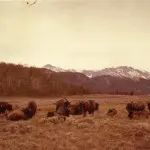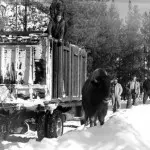In 1940 the Jackson Hole Preserve, Inc. was formed out of the Snake River Land Company. The intention was to distance the Preserve from the bad press surrounding the Snake River Land Company and impending controversy over the creation of the Jackson Hole National Monument (1943). Those involved with the Preserve announced their new initiative as a partnership with the National Park Service, formed in the name of conservation and scientific research. In Jackson Hole, the Preserve went to great lengths to disassociate with the “big business” rumors that had plagued the Land Company. After the Jackson Hole National Monument had been created, and a series of movements to remove its federal designation failed, the Jackson Hole Wildlife Park opened under the auspices of the Preserve on July 19, 1948.
The purpose of the Wildlife Park was two-fold: to increase tourist numbers coming to the newly-designated National Monument, and to offer research opportunities on the area’s megafauna. Tourists were now guaranteed a look at the region’s most charismatic ungulates, bison and elk. When the first homesteaders arrived in the mid-1880s, there were no bison left in the valley. The Wildlife Park would be the first to re-introduce the species into the ecosystem. Visitors to the Wildlife Park would drive up to the northern portion of the valley, to a dirt parking lot (still extant) just to the east of today’s Oxbow Bend turnout. There, in a large fenced meadow stood the resident herds of bison and elk. The Wildlife Park’s location was no accident, it was conveniently located a few miles down the road from the newly built Jackson Lake Lodge (1955), which was also managed by the Preserve.
While the Wildlife Park was operated under the guise of scientific research and conservation (a Research Station was created nearby), many saw the 1,500 enclosure for what it was: a park. Internationally famous conservationist and valley resident, Olaus Murie was vehemently opposed to the captivity of the wild animals. Despite his protestations, and resignation from the Jackson Hole Preserve board, the Wildlife Park transferred to the National Park Service in 1950 upon the expansion of Grand Teton National Park. The research station was transferred to the University of Wyoming ownership and the Wildlife Park became the Wildlife Range.
The range would continue to be managed by the National Park Service until 1968 when the entire herd of bison escaped for the last time. Prior to this point, individuals would find ways to break free from the fencing, but they were always brought back. With all 15 free, the decision was made to allow them to roam free. The hands-free approach to wildlife management more closely followed National Park Service policy and the bison herd grew to become today’s resident population. Today, little remains of the Jackson Hole Wildlife Park except for the large meadow east of Oxbow Bend, and the large herd of bison that roam the valley.
Text by Samantha Ford, Director of Historical Research and Outreach

